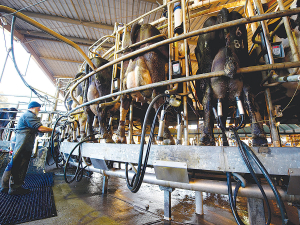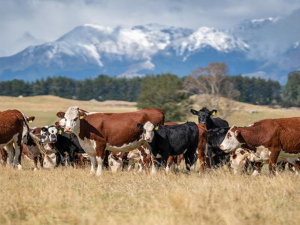NZ's dairy sector remains a star performer of our economy but still faces significant trade barrier and costs, according to a new report.
The report was commissioned by DairyNZ and the Dairy Companies Association of New Zealand (DCANZ) and prepared by Sense Partners. It highlights the dairy sector's contribution to the New Zealand economy and its role as 'shock absorber' for regional communities in times of volatility.
The report also outlines the importance of ongoing investment in trade liberalisation and resilient infrastructure.
The numbers are impressive: dairy generated nearly $26 billion in export revenues for the year to April 2023. For the year to March 2023, dairy accounted for $11.3 billion or about 3.2% of GDP. Of this, dairy farming contributes $8 billion (2.2% of GDP) and dairy processing contributes $3.4b (0.9%).
The dairy sector also employs almost 55,000 people. Māori also play a key role with Māori businesses owning around $4.9b in assets in the sector.
DCANZ executive director Kimberly Crewther says the report shows the long-term picture for the dairy sector is solid and shows it will continue to contribute significantly to the New Zealand economy.
“The value of dairy exports grew by 45% over the past five years, which helped support the national economy through the pandemic.”
DairyNZ head of economics Mark Storey says the spread of farms across the country allows dairy to support regional economies, maintaining some local spending even when milk prices drop.
“Dairy’s export earnings translate into wellpaying jobs in the sector and enable the purchase of goods and services from other sectors,” explains Storey.
“There will inevitably be an impact from the recent fall in milk price, with farmers limiting non-essential expenditure and limiting their purchases short-term where possible. However, this analysis shows that the sector itself absorbs some of the impacts in dairy farmers’ profits.”
He says despite lower milk prices, dairy farmers will continue to hire staff and purchase essential supplies to run their farms.
In the year to March 2023, dairy processors spent around $19.6 billion of goods and services from both farms (purchasing milk) and other industries. Dairy farmers in turn spent $7.9 billion on goods and services in the same period.
“At a community level, dairy is a significant employer. For instance, in Waimate, one in three jobs are in the dairy sector and wages make up 52% of total wages paid there,” he explains.
“Dairy also employs more than 20% of workers in both South Taranaki and Westland districts and pays over 40% of both districts’ total wages.”
Dairy accounts for more than 1 in 10 jobs in a further eight districts, while paying more than comparable sectors, which amplifies the value of dairy employment to communities.
Dairy processing and farming remain New Zealand’s most internationally connected industries. Individual dairy products including whole milk powder, skim milk powder, butter and dairy spreads, protein products and cheese are all multi-billion- dollar exports.
“The analysis highlights that New Zealand dairy exporters continue to change their market offerings in response to demand, with the proportion of whole milk powder reducing from 36.9% in 2019 to 31.6% in the year to April 2023, while dairy protein products having increased to 13.2% of the product mix, up from 8.6% in 2019,” says Crewther.
Trade Barriers
Kimberly Crewther the dairy industry continues to face significant trade barriers and costs.
She says reducing these will support exporters to continue growing the export value of New Zealand dairy products.
“Sense Partners estimate that New Zealand dairy exports continue to incur more than $1.5 billion of tariffs and $7.8 billion of non-tariff measures costs; 86.7% of global dairy consumption continues to sit behind trade tariffs of 10% or more,” Crewther says.
“This underscores the importance of New Zealand continuing to invest in efforts to remove trade barriers, including those that remain for dairy in some free trade agreement partner markets. Fewer trade barriers would mean a greater diversity of export opportunities for New Zealand dairy companies and greater ability to navigate market volatility.”











